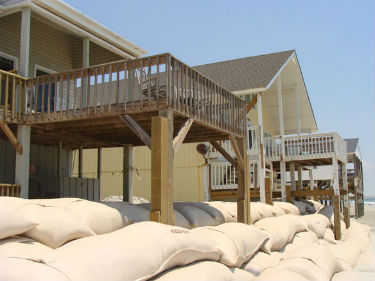RALEIGH — While much of the attention in the week ahead will be on the rollout of the N.C. House version of the state budget, there is plenty going on behind the scenes as environmental bills dealing with jetties, regulations, fracking wells and landfills are readied for a new round of hearings.
Rep. Pat McElraft, R-Carteret, said she is working on changes to two bills passed by the state Senate that should start moving soon through House committees. McElraft, co-chair of the House Appropriations Committee on Natural and Cultural Resources and the House Environment Committee, said she’s been working on a compromise to restrictions on the regulatory power of local governments contained in Senate Bill 612.
Supporter Spotlight
 Rep. Pat McElraft |
A provision in the bill prevents cities and counties from enacting environmental rules and regulations stricter than similar state or federal laws. Local governments on the coast have objected to the provision, saying it takes away their flexibility. McElraft said she has seen cities and counties take that flexibility to extremes, but in many cases the local governments do know best, she said.
“I was an Emerald Isle commissioner,” McElraft noted. “I do understand where they are coming from.”
McElraft said she is working on an amendment that would put local rules under a review procedure similar to new statewide rules and regulations. The change would allow local governments to pass ordinances stricter than state or federal laws. If they draw 10 or more letters of objection, however, the local laws would be reviewed by the N.C. Department of Environment and Natural Resources, which would then have to grant a waiver for the ordinances to take effect.
Tougher to work out is a compromise on a bill to alter 2011 legislation that allowed for four small jetties, called terminal groins, at inlets along the beach. Sens. Bill Rabon, R-Brunswick, and Harry Brown, R-Onslow, have been pushing a bill that passed the state Senate to allow an unlimited number of groins while relaxing or gutting financial requirements and environmental protections. Environmentalists, Gov. Pat McCrory and the state Department of Environmental and Natural Resources have opposed the move, preferring that the four projects allowed under the 2011 legislation be allowed to run their course.
The projects — Holden Beach, Ocean Isle Beach, Bald Head Isle and Figure 8 Island — have yet to apply for state permits. They are currently working through an environmental review process required by the Army Corps of Engineers.
Supporter Spotlight
McElraft said she agrees with Brown and Rabon’s assertions that the state set the bar so high that the projects can’t be built. She said the Senate bill lowers the bond requirement on potential damage from the jetties. The bonding wording in the old bill is too vague, McElraft said, and makes it difficult for communities to obtain the bonds.
“Right now it is so wide open that the bonding companies are saying ‘we don’t know where to begin,’” she said.
 The rules regulating sandbags on the beach offer a cautionary tale about the state’s ability to force the removal of terminal groins that are damaging the beach or private property. Photo: Coastal Care |
McElraft said she is working on changing the bill to reinstate the four-groin cap but require that project sponsors only prove that they have the money to remove the structures if they fail.
“To me, that makes sense,” she said, “to have enough money to get it out of there and get it out quickly.”
That may be more easily said than done if the history of state’s rules about “temporary” sandbags on the beach offers any guidance. The state in 1985 began allowing sandbags as “temporary” measures to protect buildings imminently threatened by erosion. The bags were supposed to be removed once the buildings were no longer threatened, but beach towns began petitioning the state to prevent the bags from being removed and some homeowners simply ignored the rules. The state Coastal Resources Commission amended the rules several times to give towns and homeowners more time. It finally gave up earlier this year and passed weakened rules. Some of those “temporary” sandbags have been on the beach for more than two decades.
McElraft said she is also in favor of allowing communities more flexibility in financing options for terminal groins and supports the language in the senate bill that would not allow sea-level rise to be a part of the regulatory framework for groins.
No Injection Wells in House Fracking Bill
While the House and Senate have yet to work out agreements on jetties and local regulations, the House did make headway on a bill to step up the pace for state approval of hydraulic fracturing for natural gas. The House Commerce and Job Development Committee this week passed its rewrite of Senate Bill 76, the Domestic Energy Jobs Act, which drops a provision that would have lifted a state ban on using injection wells for wastewater for fracking fluids.
Several coastal communities passed resolutions opposing the injection wells and House members, including Rep. Rick Catlin, R-New Hanover, a hydrogeologist, fought the change, saying the coastal aquifers would be most at risk if the ban on wastewater, in place since 1972, is lifted.
Sen. Buck Newton, R-Wilson, a chief sponsor of the bill in the Senate said the issue was a “canard set up by the environmental community” and that newspapers were printing “nonsense” about the risks to the coast. He said it would be costly for fracking companies to truck their wastewater that far.Although the injection well provision was dropped in the House version, discussion of the issue highlighted the disagreement between the two chambers.
Coastal representatives sought to assure Newton that some of the communities they represent did not think the concern was nonsense. Used fracking water is routinely hauled hundreds of miles to injection wells in Ohio and Pennsylvania, they noted. In fact, so much wastewater is hauled around that an entire industry has developed in fracking country to haul the water around.
Catlin said he was glad to see the injection well provision taken out of the bill and would stay focused on the issue as the state’s Mining and Energy Commission develops rules for fracking.
“The only place permeable enough for injection of wastewater is in the coastal aquifers,” he said. “We need to keep that on our radar.”
Another portion of the bill aimed at pushing ahead with a regional compact for offshore oil and gas exploration also drew attention. Rep. Paul Tine, D-Dare, said a revenue sharing proposal in the bill ought to include some portion for local governments. He said offshore activities present a risk to the economies that depend on tourism and fishing, and a state fund that would help finance cleanup in the event of emergencies ought to include a local share.
“It’s a risk that comes without any return on that risk,” he said.
The bill now moves to the House Environment Committee.
New Landfill Bill Guts Safeguards
 A new bill removes or weakens environmental safeguards on large landfills. Photo: Ecofriend |
The Senate Agriculture, Environment and Natural Resources Committee approved a substitute bill yesterday that guts or weakens provisions in a 2007 bill meant to prevent mega-dumps from being built in swamps and other environmentally sensitive areas. Under the bill, landfill operators had to prove that they have the money to operate and safely close a landfill. It also charged higher fees, set new design standards and prevented landfills from being built within five miles of a national wildlife refuge, two miles from a state park and a mile from state game lands.
The bill passed by the committee reduces that buffer to 1,500 feet, removes prohibitions on landfills being built in floodplains or in sensitive natural areas that would result in severe ecological damage, weakens streamside buffers and environmental monitoring requirements and drops the condition that new landfills undergo an environmental review.
The legislature passed the 2007 bill in response to mega-landfills planned in the Green Swamp in Columbus County and elsewhere. The fear then was these massive dumps would import trash from metropolitan areas along the East Coast.








